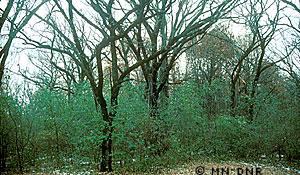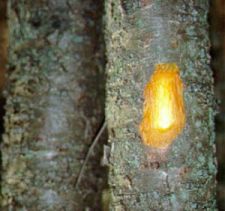Buckthorn Removal Techniques
Buckthorn Removal & Control Information
Buckthorn History
Buckthorn is native to Eurasia but has been commonly planted in this country as a hedge. Some states have made it illegal for nurseries to sell and other states have not. It was widely recommended for conservation plantings in the Midwest until its invasive tendencies became apparent; it creates dense thickets and competes with native vegetation. Buckthorn's fruit is widely dispersed by birds and small mammals, leading to further growth and invasion. The sale of common buckthorn was halted in the 1930s after it was discovered that it is an alternate host to oat crown rot, a fungal disease of oat crops. All of these reasons lead to buckthorn killing native plant species and disrupting the entire ecosystem.


Glossy Buckthorn or Common Buckthorn?
Usually buckthorn has multiple stems from the base. The brown bark has prominent pale colored protuberances called lenticles. The inside wood itself is orange or yellow. Glossy buckthorn has spines erupting from the stem and branches, unlike common buckthorn with spines located at the ends of twigs between the terminal leaves. Check for spines at the end of twigs between the last leaves. If the interior wood is orange and yellow and it has these spines, then it is common buckthorn; if the wood is orange and yellow and it has no spine, then it is glossy buckthorn.
Buckthorn, like many invasive shrubs, sprouts leaves in early spring and retains these leaves late into fall, increasing energy production and shading out native plants. It is very easy to identify buckthorn during this period of time. It is the only green plant you see during these times of the year, normally during winter months. If it is caught early in its initial invasion, it may be eradicated completely.
Why is Buckthorn control needed?
- Out-competes native plants for nutrients, light, and moisture
- Degrades wildlife habitat
- Threatens the future of forests, wetlands, prairies, and other natural habitats
- Contributes to erosion by shading out other plants that grow on the forest floor
- Serves as host to other pests, such as crown rust fungus and soybean aphid
- Lacks "natural controls" like insects or disease that would curb its growth
Identifying Buckthorn (video on how to identify buckthorn)
Usually buckthorn has multiple stems from the base. The brown bark has prominent pale colored protuberances called lenticles. The inside wood itself is orange or yellow. Orange = Buckthorn.
Glossy buckthorns have spines erupting from the stem and branches unlike common buckthorns that have spines located at the ends of twigs between the terminal leaves.
For more information on controlling buckthorn, and killing buckthorn, see Buckthorn, what you should know.
Where is Buckthorn?

Developing a Buckthorn Removal Plan
Prioritize sites for treatment and plan carefully. Assessing both how big the problem is and any other help available is a critical first step:
- Map known populations on your control site; is the species widely distrib¬uted throughout your area to control
- Just beginning to appear?
- What size trees are in the area?
- What tools will be needed to cut down the trees?
- Is it sparsely scattered in otherwise native vegetation (do not use chemicals in these areas to avoid unwanted plants being killed?
Given this information, develop a strategy for control:
- Prioritize heavily infested sites where success can be achieved for treatment;
- Choose appropriate control methods, given site conditions and available resources.
- Focus on mature plants, particularly those in full sun with abundant fruit;
- Treat larger core infestations first.
- Monitor to ensure desired results are being achieved; adapt management to improve success.
Cut and Cover method (video information) https://www.youtube.com/watch?v=qirBYf-SArQ
Use loppers or a saw to cut buckthorn down and then attach plant killing bag to the stump as per manufactures instructions. The Buckthorn Baggie is chemical free way to kill glossy buckthorn, common Buckthorn, and almost every other tree that does not use root sucker to promulgate. If the nodes grow from the root crown and above the cut and bag method will kill the buckthorn. How to kill buckthorn is covered in full on this site. Controlling buckthorn and its effects.
Mechanical control
In the very earliest stages of invasion, when only scattered seedlings and young plants are present, mechanical controls such as pulling and digging may be adequate to control or eradicate glossy buckthorn. These methods are not impractical in larger, established infestations, with mature shrubs, it just takes more effort. Many agencies opt for chemical control in large infestations but the just equals more chemicals in our forest.
Pulling
In loose, sandy soils, buckthorn seedlings can be hand-pulled easily, particularly when the soil is moist and the population is small. Pull steadily and slowly to minimize soil disturbance and tamp down the soil afterwards. In heavier soils, however, roots are so tenacious that the bark strips off the seedling when pulled. Tools such as a pulling broom provide additional leverage, facilitating the removal of somewhat larger plants. This does lead to big holes in the forest floor and allows existing buckthorn seeds to geminate easier in the loosened soil. Products such as the Buckthorn Baggie alleviate this problem.
By now, most people know that buckthorn is not a welcome plant in North American woodlands. One big issue is changing the attitude that fall is the best time to control buckthorn. Spring is the best time of year to eliminate buckthorn with the cut and cover method. After the primary loss of native plant habitat to agriculture and community developments, our remaining native forest under-story have become difficult to find in most developed areas. Invasive, non-native species have intruded natural and not-so natural areas all across the United States. Throughout Minnesota and 27 other states, buckthorn had been quietly invading for decades. Brought over from Europe and sold at plant nurseries across the Midwest. The under-story species of our woodlands and savannas, parks and wood lots, and fence-rows, are in danger not only from the invasive competition of a couple varieties of buckthorn, but the overzealous under-story clear-cutting by well-meaning buckthorn busters. Our native species--both woody and herbaceous--have all but disappeared from the lower canopies of the most severely buckthorn infested areas. This is a serious problem that can be won by hard work and our innovation.
A Buckthorn Conference held October 3rd, 2001 at the University of Minnesota Landscape Arboretum was the first of its kind in Minnesota. Participants learned about two species of buckthorn invaders: Glossy Buckthorn Frangula alnus (Rhamnus frangula) and Common Buckthorn Rhamnus cathartica. Information on buckthorn's, biology, history, range, and control was covered in detail. Many articles have been published in Twin Cities newspapers about buckthorn, one went into great detail on the cut and cover method of control which included using the Buckthorn Baggie control method. Following is a summary of the threats of buckthorn, and details on effective methods for its control.
History, Range, and ID
Buckthorns are shrubs that grow into medium and small trees. Near urban centers and towns, you will find buckthorn to be the predominant shrub in the understory starting at most woodland edges of what remains of our native, Minnesota woods.
Common buckthorn is native to Sweden, Russia, Siberia, Xinjiang China, and the northern Caucasus mountains. It was first imported from Europe to the US in the mid-1800s and about 1890 in Canada. The species was used primarily in hedge plantings because it shears nicely. Shelter belts and wildlife plantings are another reason it was planted. However the buckthorn berries and not a good food source for our wild life species.
Flowers of buckthorn appear with the leaves in spring they are tiny, very inconspicuous, and light-medium green. Male and female trees are completely separate plants. Shrubs that have been allowed to "grow naturally," come to be multi-stemmed, small trees. Female plants produce vast quantities of black fruit that are transported through bird droppings. This invader now thrives in upland woods, parks, fence-rows, yards, and farm shelterbelts.
Currently, 76 of Minnesota's 87 counties have buckthorn on the loose. Nation-wide it thrives in 28 states. Buckthorn's current continental range is bound by Nova Scotia Canada, Saskatchewan Canada, NE Kansas USA, and North Carolina USA.
Glossy buckthorn, the other buckthorn invader, was sold under several names: Columnar, Tall hedge, or Fern-leaf buckthorn. It is native to most parts of Europe except the extreme north, and part of the Mediterranean region. It was introduced to North America in the early 1900s and has been used as a landscape shrub it thrives primarily in rich, moist and wet soils.